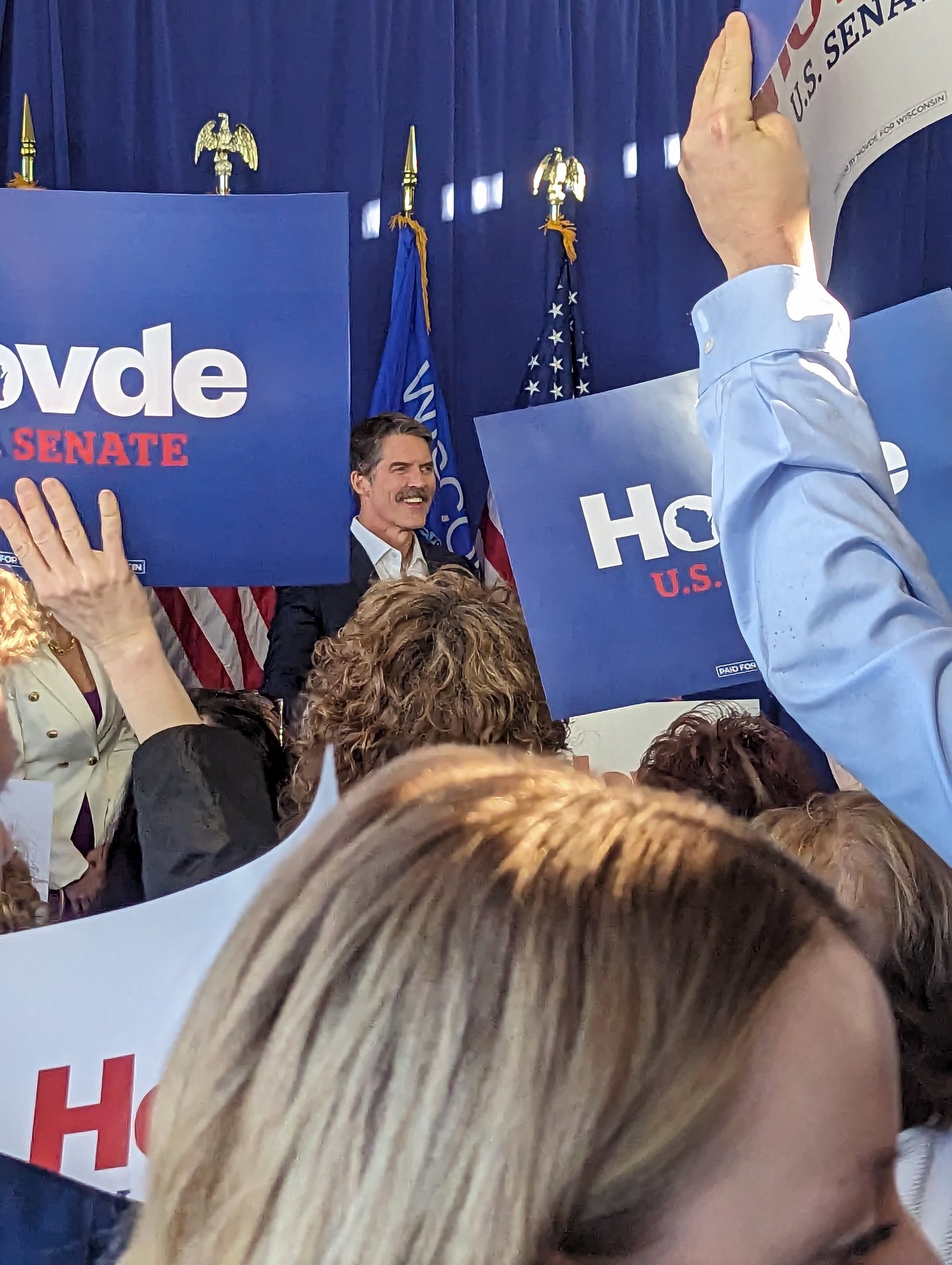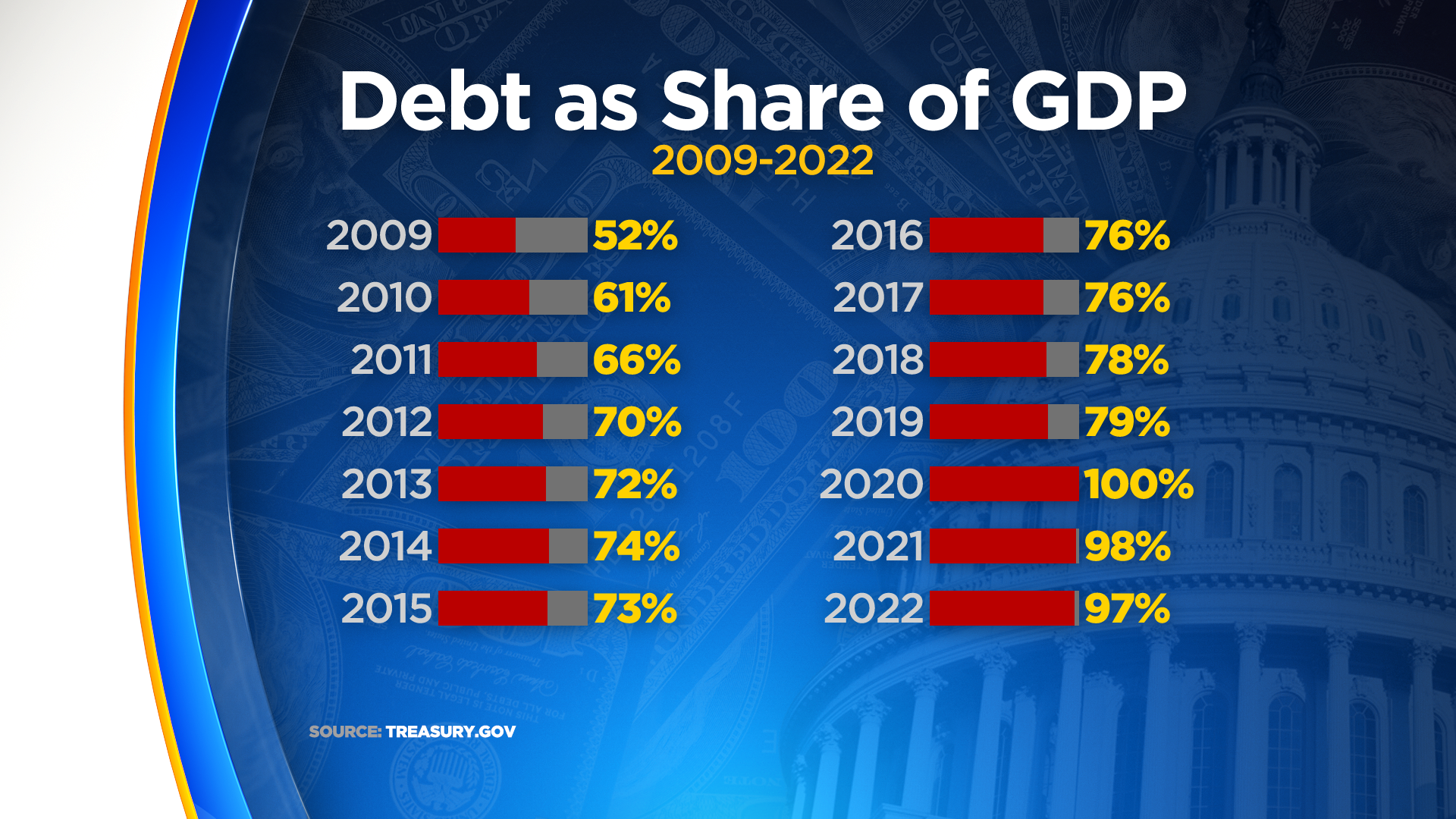MILWAUKEE (CBS 58) — When Eric Hovde launched his campaign last Tuesday as a Republican challenger to Sen. Tammy Baldwin (D-Wis.), he highlighted three issues: The economy, public safety and illegal immigration. In his remarks on federal debt and how the “defund the police” movement relates to Wisconsin’s biggest city, Hovde omitted important context around those issues.
Hovde’s campaign did not make the Madison businessman available for an interview, but it did provide a response to CBS 58’s questions about the two topics.
On the issue of debt, the topic is almost impossible to ignore if you’re on Interstate 43 south approaching the Marquette Interchange. A billboard sponsored by the Peter G. Peterson Foundation displays a running count of the total federal debt. On Tuesday, the number read $34,376,541,211,846.
During his campaign launch last Tuesday in Madison, Hovde compared the debt added under President Joe Biden to the debt amount during the first two centuries of the country’s history.
“Economically, we’ve racked up more debt in the last three-and-a-half years than our country’s first 230 years,” Hovde told supporters. “Think of that for a moment.”
Hovde’s campaign website notes the U.S. has added more than $7.3 trillion in debt since the end of Fiscal Year 2020. However, the federal fiscal year ends in September, so that $7.3 trillion figure includes the last four months of Donald Trump’s presidency, since President Biden was not inaugurated until late January 2021.
Beyond that, targeting only the current president for racking up debt ignores how debt rose under his predecessors. So far, federal debt has risen by $6.5 trillion during President Biden’s first three-plus years. Under Trump, debt went up by $7.9 trillion over his one term, and over Barack Obama’s two terms, the federal government added $9.2 trillion, according to Treasury.gov.
In a statement, Hovde said his frustration was not confined to just one president, even though he singled out Biden during his campaign launch.
“Politicians from both parties have buried future generations under mountains of debt,” Hovde said. “I’m not a career politician like Senator Baldwin and I can’t be bought. It will take leaders from outside of government who aren’t afraid to stand up to special interests.”
Kundan Kishor, who chairs the economics department at UW-Milwaukee, said when analyzing federal debt, it’s not particularly useful to just look at the raw numbers.
“So, that’s not apples-to-apples comparison,” Kishor said. “Because size of the economy today is much larger than it used to be.”
Instead, Kishor said it’s better to look at debt as a share of the economy, commonly measured as the Gross Domestic Product (GDP). Debt as a share of GDP has risen considerably going back to 1980, when the debt share was 26%.
That number rose to 48% in 1995 before dropping to a recent low of 31% in 2001. Since then, debt as a share of GDP has skyrocketed.
By the time Obama took office in 2009, the debt share was 52%. Over his two terms, that figure rose to 76%, which included a surge in federal spending to combat the Great Recession, which began in 2007 and lasted throughout the rest of the decade.
Under Trump, debt relative to GDP went from 76% to 100% in 2020; during that first year of the COVID-19 pandemic, emergency federal spending drove the debt share from 79% to 100%.
During the first half of Biden’s first term, the debt share creeped downward to 97% in 2022, the most recent year for which data are available on the Treasury’s website.
“It’s not a problem that is there only because of, say, Biden,” Kishor said. “This problem has been there for a pretty long period now.”
Milwaukee and “defund the police”
On the issue of crime, Hovde last Tuesday evoked the “defund the police” movement that many liberals took up during the summer of 2020 after Minneapolis police killed George Floyd in an incident that sparked nationwide riots, including in Milwaukee and Madison.
“We had one of the, I’m sorry, dumbest ideas of all time: ‘Defund the police.’ How has that worked out?” Hovde said. “Horribly for our major cities, particularly.”
Hovde then referred to the “defund police” concept while appearing on a national conservative radio show.
“You know, the left has given us, probably, the dumbest idea of the last 100 years, and that is ‘defund the police’ and go soft on criminals,” Hovde told The Clay Travis and Buck Sexton Show. I was just in south Milwaukee; everybody was talking about it.”
Ostensibly, Hovde was referring to the south side of Milwaukee and not the suburb of South Milwaukee. His social media account shared video from a campaign event at a Puerto Rican restaurant on the city’s south side last Wednesday.
Hovde’s campaign noted the Republican candidate has not specifically accused Milwaukee of defunding its police department, but Hovde’s spokesman referred to Milwaukee’s 2021 budget, in which the city cut more than 100 police positions.
At that time, Mayor Cavalier Johnson was president of the Common Council, which barely passed the budget by an 8-7 vote. Some of the alders who voted against the budget wanted the city to cut police spending by $75 million and reallocate the money elsewhere, but that didn’t happen.
On social media, Johnson pushed back on Hovde’s remarks, noting Milwaukee has increased police spending during his two budgets as mayor.
Rob Henken, president of the Wisconsin Policy Forum, has analyzed Milwaukee’s budget for the last 15 years. He noted that while Milwaukee lost some of its sworn strength, those savings were not redistributed to other agencies, which is specifically what “defund” activists seek.
“There’s about 140 fewer officers on the street than there were in 2020,” Henken said. “But you really have to look at why that has occurred.”
Henken referred to previous budgets where other departments, such as libraries and health, took cuts before MPD. Eventually, he said the state’s tight restrictions on how local governments can raise money — until last year, Milwaukee wasn’t allowed to have a city sales tax — forced police cuts.
Basically, Milwaukee eliminated police positions because it was cutting across the board.
“While, indeed, police staffing levels have been cut, we have not seen a redirection of the savings from those reduced staffing levels to other city services,” Henken said.
As a percentage of Milwaukee’s general budget, MPD accounted for 46.6% in 2020, 46.2% in 2021, 45.9% in 2022 and 46.9% in 2023. The hope is that in 2024 and beyond, having a new 2% city sales tax will allow for city spending to increase; that certainly includes the police department, as additional public safety positions are a state-imposed condition of the new tax.
Henken said that share is comparable to the rest of the state’s municipalities, which tend to dedicate between 40% and 50% of their budgets to police.
Notably, before anyone had even heard of Floyd, Henken said the state Legislature’s previous refusal to increase shared revenue played a role in local governments slashing police funding. A 2021 policy forum study found between 2018 and 2019, 253 Wisconsin municipalities reduced their spending on police.

